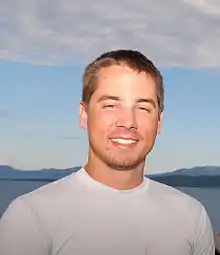Marin Medak
Marin Medak (born 1987) is a Slovenian adventurer.

Medak is one of the youngest ocean rowing expedition leader and the first Slovenian to row across the Atlantic Ocean.
Medak lives in Piran and is a student at the Faculty of electrical engineering on the University of Ljubljana. He started sea kayaking in early 2009 and after four months departed for his first solo sea kayaking adventure. He paddled the islands of Dalmatia (Croatia), starting at Lošinj (Croatia)and finishing in Zadar (Croatia).
A year after he kayaked solo 1400 km from Savudrija (Croatia) to the Island of Zakynthos (Greece).
In 2011, he persuaded experienced sea kayaker Simon Osborne (UK) to come with him to South Korea. In March 2011, after 23 days of temperature around or below freezing, the duo become the first to successfully paddle the length of the coast of South Korea.[1] In the same year Medak and his Paralympian friend Gal Jakič try to set a speed record for kayaking the coast of Croatia, but had to abort the expedition due to medical problems.
After three years of adventures around the world it was time for Medak to live his dreams and row across the Atlantic ocean. In early 2012 he successfully skippered a four-man Slovenian-British Ocean Rowing expedition Tušmobil TransAtlantik. He was joined by three UK rowers, Simon Osborne, Stephen Bowens and Alastair Humphreys.[2]
Medak is supporting and raising funds for Društvo KROS, a charity organization that helps with children rehabilitation after neural injuries.
After his extreme expeditions, Medak ventured into entrepreneurship.
In April 2013 he launched a keyring brand, Hobkey, with keyrings for sea and whitewater kayakers, scuba divers and canoeists. At the end of 2013 Medak and Gigodesign, a design studio from Ljubljana, Slovenia, partnered to make the smallest iPhone charger on the go. After a year of work they launched Oivo,[3] a charger that uses AA batteries to power the phone and small enough to fit as a keyring.
Oivo was launched on Kickstarter in September 2014. In 18 days they raised more than $26,000, but the team decided to cancel the campaign due to too many mistakes made in the go-to-market phase. They tried to sell the whole product, but were unsuccessful. The project was abandoned in November 2014.
In January 2015 Marin joined forces with an Australian adventurer, Huw Kingston,[4] to become the first to row the Eastern Mediterranean from Tunisia to Turkey. They started in Hammamet stopped in Malta, Foinikounta, Monemvasia and finished 1750 kilometers and 49 days later in Çeşme. For the last two legs, Dimitris Kokkoris [5] joined the expedition. Due to delays by unfavorable winds, Huw had to skip the last let and end his rowing leg earlier, to continue his bigger expedition Mediterr Année.[6]
Expeditions
| Period | Expedition | Distance | Description | |
|---|---|---|---|---|
| July 2009 | Padlling the coast of Dalmatia | 700 kilometers | Start 13.7.2009 island of Lošinj – paddling to Dubrovnik – back to Zadar. Finishing 13. August 2009. Time needed: 1 month. | |
| 2010 | Savudrija - Zakynthos | 1400 kilometers | Paddling from Savudrija ( Croatia ) to Zakynthos ( Greece ). Time needed: 1 month. | |
| 2011 | Expedition South Korea | 1100 kilometers | Start in Jeongok Harbor (South Korea) and finishing at Sokcho Harbor (South Korea). Time needed: 23 days. | |
| 2011 | Croatian coast speed record | 550 kilometers | Starting at Prevlaka peninsula (Croatia ), with an intended finish in Piran (Slovenia) Expedition aborted on the island of Unije for medical reasons. Marin continued solo and finished in Piran (Slovenia). Time needed: 10 days. | |
| 2012 | Expedition Tušmobil Transatlantik2012 | 4700 kilometers | Rowing across the Atlantic ocean Start on Gran Canaria (Spain) and finishing in Port St Charles (Barbados). Time needed: 45 days and 15h. | |
| 2015 | Expedition Eastern Mediterranean | 1750 kilometers | Started in Hammamet (Tunisia), stopped in Malta,Foinikounta (Greece), Monemvasia (Greece) and finished in Çeşme (Turkey) . Time needed: 49 days. | |
| 2016- | Male avanture (Small adventures) | He and his camera guy are exploring Slovenia & Croatia on adventures that last for 2–3 days. | ||
References
- (Yonhap News Agency) Two foreigners become first kayakers to circumnavigate Korean Peninsula
- Ocean Rowing Society INT. archive 2012 Archived 2012-05-22 at the Wayback Machine
- Oivo - charge your iphone using AA batteries
- "Australian adventurer faces last leg of epic journey". BBC News. Archived from the original on 2016-06-17.
- Ο Δημήτρης Κόκκορης συζητάει για την τελευταία του προσπάθει
- 15000 km, 20 Countries - 12 months